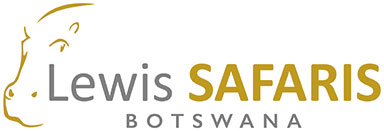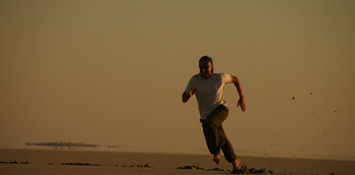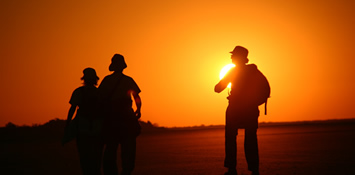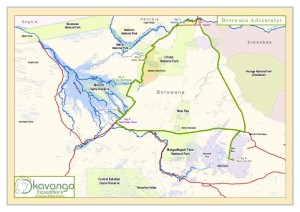
Botswana Adventurer Safari Itinerary
ITINERARY
The safari truck will collect clients from the Zimbabwean border at 11am and will then proceed to Kasane to meet any other guests at Kalahari Tours and Coffee Buzz at 12.30pm. Spend the afternoon on a game drive in Chobe National Park which is world renowned for large herds of elephant. The Chobe River Front boasts an impressive bio-diversity of species including lion, hippo, buffalo and puku, wild dog and sable antelope.
Meals Provided: Lunch & Dinner
Chobe to Savute is approximately a 4-6 hour drive via the village of Kachikau. From here we drive on 4×4 tracks through the Chobe Forest Reserve via Gcoha Gate. We arrive in Savute around midday for lunch. A dominant feature of Savute is the Hills, one of which has a few preserved bushmen paintings which are easily accessible on your afternoon game drive. Savute has a healthy population of leopard who live on the hills & the best time to see them is either first or last light. The Savute Channel now flows into the marsh for the first time in over 30 years turning the Savute Marsh into a veritable paradise for birds & animals.
Meals Provided: Breakfast, Lunch and Dinner
Departing Savute early morning, the drive takes 3-4 hours but is hugely dependant on local conditions and arrive in Moremi around midday for lunch. You will spend the afternoon on game drive. Moremi area is one of the most beautiful and varied reserves found on the African continent with huge concentrations of wildlife and incredibly beautiful scenery. We camp for the night in either the Khwai, Xakanaxa, 3rd Bridge or South Gate area. The campsite for the night will be in the Moremi Game Reserve or the surrounding community managed wildlife management area.
Meals Provided: Breakfast, Lunch and Dinner
Moremi Game Reserve to Maun is approximately a 4 hour drive. The safari packs up & leaves camp following an early morning game drive and will enjoy a picnic lunch en-route to Maun arriving late afternoon. Optional activities (time permitting) include a scenic flight over the Okavango Delta in a fixed wing aeroplane or helicopter. Alternatively a horse ride can be arranged. A scenic flight is highly recommended as it gives you a bird’s eye view of the Okavango Delta.
Meals Provided: Breakfast, Lunch and Dinner
Maun is the gateway to the Okavango Delta. Today we venture out into the ‘Delta’ in mekoros (dug-out canoes) experiencing the myriads of waterways and secret lagoons. The mekoros are poled by poler’s from the local villages. The Delta is a huge inland water system dotted with thousands of islands that are a haven for a diverse array of wildlife. This is a unique environment where dry land and water collides. Time spent in the Delta is approximately 6-7 hours.
Meals Provided: Breakfast, Lunch and Dinner
From Maun we travel to the Makgadikgadi Salt Pans approximately a 4-6 hour drive – vast shimmering salt flats on the edge of the Kalahari basin. We stop for lunch at Chapmans Baobabs also known as the seven sisters and reputed to be one of the largest trees in the world. The last night is spent sleeping out under the night sky under a blanket of stars.
Meals Provided: Breakfast, Lunch and Dinner
The drive from the pans to Kasane is approx 350km which takes roughly 4-6 hrs. This is a transfer to reach the border at approximately 1 pm. The safari will pack in the morning and head for Kasane via the villages of Gweta and Nata. Just after Nata you pass through an agricultural area known as Pandamatenga, which is the only crop producing area in Botswana. From Pandamatenga to Kasane look out for elephant and sable antelope.
Meals Provided: Breakfast and Lunch
HIGHLIGHTS
The Okavango is a unique ecosystem, an inland delta situated in the middle of the largest stretch of continuous sand in the world – the Kalahari basin. This wetland lies like an oasis in an otherwise inhospitable landscape. Where land and delta meet, a mosaic of pans, grasslands, forests and lagoons provide an extremely rich and diverse habitat in which a multitude of animals and birds flourish. This wetland is one of the natural wonders of the world, and is a fragile ecosystem that remains one of the world’s least spoilt and most beautiful wildernesses, and is home to various unique species e.g. sitatunga antelope and red lechwe.
Moremi Game Reserve is situated in the eastern corner of the Okavango Delta. Moremi is one of the most beautiful and varied reserves found on the African continent with huge concentrations of wildlife and incredible scenery. The reserve consists of both swamped areas e.g. Xakanaxa, and dry-land areas e.g. Khwai.
The Savute is characterised by the Savute Marsh, the Savute Channel and the Hills. During morning and late afternoon drives your guide will alternate between these areas. Anything can happen on the Savute Marsh and it’s best to get there early in the morning.
A dominant feature of Savute are the Hills, one of which has a few perfectly preserved San bushmen paintings which are easily accessible. Savute has a very healthy population of leopard who live on these hills and the best time to see them is either first or last light as they leave their stony refuge to hunt in the surrounding bush. In sharp contrast to the lush Chobe riverfront is the seemingly endless desolate landscape of the Savute, famous for the dry marsh, sand ridge and volcanic hills, which are unique to this area. The marsh once contained the waters of the Makgadikgadi superlake, and the most typical feature of the landscape is the abundance of dead trees – evidence of the erratic flow of the Savute channel over the years. The area consists of large open game-filled plains, and is home to a variety of dry-land animals, including zebra, wildebeest, kudu, giraffe, wild dog, leopard, cheetah and lion.
The Chobe National Park is one of Africa’s finest game sanctuaries. Situated in the far north of Botswana, Chobe encompasses a wide variety of diverse habitats offering extreme contrasts and is home to a breath-taking variety of animals and birds.
Lying southeast of the Okavango Delta and surrounded by the Kalahari Desert, Makgadikgadi is technically not a single pan but many pans with sandy desert in between, the largest being the Sua (Sowa), Nwetwe and Nxai Pans. A dry salty clay crust most of the year, the pans are seasonally covered with water and grass, and are then a refuge for birds and animals in this very arid part of the world. The climate is hot and dry but with regular annual rains.
These salt pans cover 6,200 sq mi (16,057.9 km2) in the Kalahari basin and form the bed of the ancient Lake Makgadikgadi, which evaporated many millennia ago. The pans themselves are salty desert whose only plant life is a thin layer of blue-green algae. However the fringes of the pan are salt marshes and further out these are circled by grassland and then shrubby savanna.
Very little wildlife can exist here during the harsh dry season of strong hot winds and only salt water, but following a rain the pan becomes an important habitat for migrating animals includingwildebeest and one of Africa’s biggest zebra populations, and the large predators that prey on them. The wet season also brings migratory birds such as ducks, geese and Great White Pelicans. The pan is home of one of only two breeding populations of Greater Flamingos in southern Africa, and only on the Soa pan, which is part of the Makgadikgadi pans
CLICK HERE FOR FULL MAP





